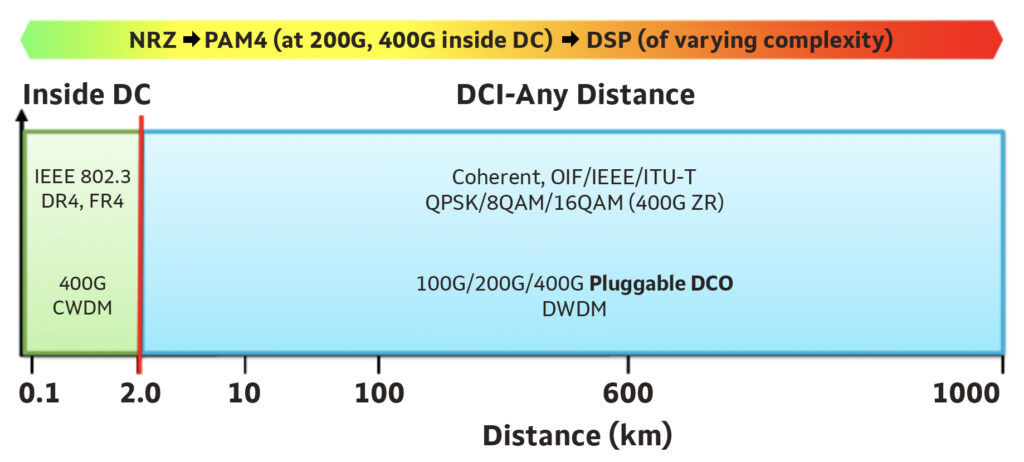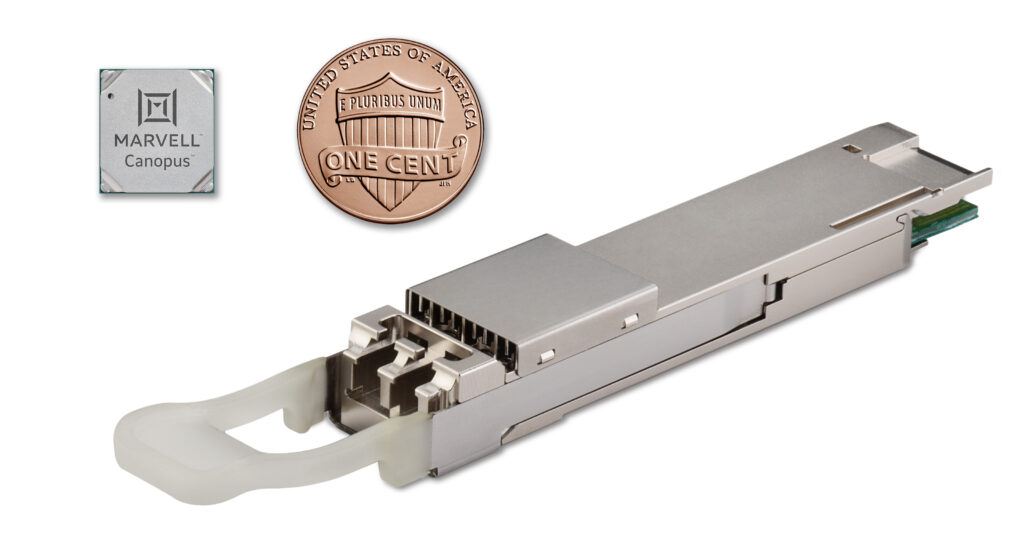- PRODUCTS
- COMPANY
- SUPPORT
- PRODUCTS
- BY TYPE
- BY MARKET
- COMPANY
- SUPPORT
Low Power DSP-Based Transceivers for Data Center Optical Fiber Communications
As the volume of global data continues to grow exponentially, data center operators often confront a frustrating challenge: how to process a rising tsunami of terabytes within the limits of their facility’s electrical power supply – a constraint imposed by the physical capacity of the cables that bring electric power from the grid into their data center.
Fortunately, recent innovations in optical transmission technology – specifically, in the design of optical transceivers – have yielded tremendous gains in energy efficiency, which frees up electric power for more valuable computational work.
Recently, at the invitation of the Institute of Electrical and Electronics Engineers, my Marvell colleagues Ilya Lyubomirsky, Oscar Agazzi and I published a paper detailing these technological breakthroughs, titled Low Power DSP-based Transceivers for Data Center Optical Fiber Communications.
For readers seeking a technical understanding of these innovations, I encourage you to read the paper. But in the broadest terms, the paper explores the complex trade-offs in designing Digital Signal Processing (DSP) ASICs, including the choice of modulation format, baud rate, optical link design, forward error correction, signal shaping and dispersion compensation – all interrelated factors that together can have a critical impact on energy use.

This power efficiency matters a great deal, because the use of DSP-based modules has proliferated over the past decade for data rates higher than 100Gbit/s. No longer just used for long-haul communications between data centers (DCI – Data Center Interconnects), DSPs of varying complexity are now used within them, at all stages of deployment. Over this same period, new design paradigms have dramatically improved performance, even as they reduced DSP power usage by an astounding 50X.
DSP ASICs also need to be small enough to fit into an optical transceiver. The Marvell® Canopus™ DSP used for coherent transmission between data centers, for 10km to 1000km applications, is shown below with the optical transceiver for size comparison.

Power efficiency is critical to scaling bandwidth, because supplying more electrical power to any given data center, as computing demand soars, is neither practical nor cost-effective. And because a lot of energy is already dedicated to data center cooling, finding other opportunities for efficiency becomes critical to optimizing overall data center performance. Integrating more advanced optical interconnects presents one of the biggest opportunities for gains in speed, accuracy, and efficiency.
In the Optical and Copper Connectivity Business Unit at Marvell, we are working to improve interconnect speed, interconnect density, or optimizing power usage for our customers. Our DSP-based transceivers are a great example of this, owing their efficiency and effectiveness to the ingenuity, collaboration and focus of a highly motivated engineering team. Thanks to them, we consistently translate academic theory into practical engineering reality, and that capacity for true, breakthrough innovation makes all the difference.
Marvell SVP and CTO, Optical & Copper Connectivity, Dr. Radha Nagarajan is a Fellow of the Institution of Engineering and Technology, a Fellow of the Optical Society, and a winner of the IEEE LEO Aron Kressel Award for his contributions to the commercialization of Large Scale Photonic Integrated Circuits.
Tags: coherent transmission, Data Center Interconnects, Data Center Optical Fiber Communications, Digital Signal Processing, DSP ASICs, DSP-based modules, DSP-Based Transceivers, Optical Fiber Communications, optical link design, optical transmission technology
Recent Posts
- Custom Silicon: A Sea Change for Semiconductors
- Marvell Named to America’s Most Responsible Companies 2026 List
- 5 Times More Queries per Second: What CXL Compute Accelerators Can Do for AI
- Marvell Makes Inaugural 100 Best Companies in Southeast Asia List
- Marvell Earns “Fittest Firm” Title in Silicon Valley Turkey Trot for 10th Consecutive Year
Archives
Categories
- 5G (10)
- AI (46)
- Cloud (19)
- Coherent DSP (11)
- Company News (107)
- Custom Silicon Solutions (9)
- Data Center (69)
- Data Processing Units (21)
- Enterprise (24)
- ESG (10)
- Ethernet Adapters and Controllers (11)
- Ethernet PHYs (3)
- Ethernet Switching (41)
- Fibre Channel (10)
- Marvell Government Solutions (2)
- Networking (43)
- Optical Modules (19)
- Security (6)
- Server Connectivity (32)
- SSD Controllers (6)
- Storage (23)
- Storage Accelerators (4)
- What Makes Marvell (47)
Copyright © 2026 Marvell, All rights reserved.
- Terms of Use
- Privacy Policy
- Contact

